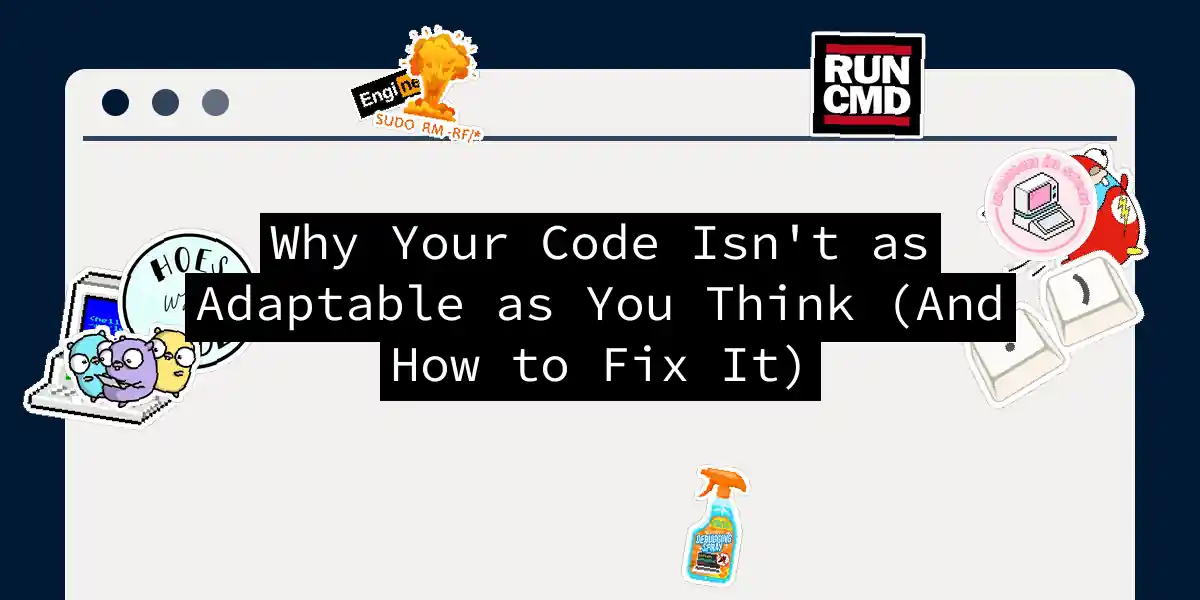Picture this: You’ve just crafted a “masterpiece” of flexible code. You high-five your rubber duck, deploy with confidence, and promise stakeholders, “This’ll handle ANY future change!” Fast forward three months: Product needs “one tiny tweak.” Suddenly, your “flexible” code resembles overcooked spaghetti – resistant to change and full of surprises. Been there? Let’s dissect why code adaptability is often a mirage.
The Myth of “Future-Proof” Code
We’ve all fallen for the siren song of over-engineering. You abstracted everything, created interfaces for interfaces, and built a dependency injection framework that requires a Ph.D. to configure. Result? Your code is “flexible” in theory but brittle in practice. Why? Adaptability ≠ complexity. True flexibility emerges from strategic simplicity, not cathedral-like structures.
Concrete Nightmares: The Dependency Trap
// "Adaptable" Payment Processor? Think again.
class PaymentService {
private StripeProcessor stripe = new StripeProcessor();
void processPayment() {
stripe.charge(); // Direct concrete dependency
}
}
Want to switch to PayPal? Rewrite PaymentService, modify tests, redeploy. The culprit? Rigid coupling. New requirement = surgery.
The 5 Silent Adaptability Killers
1. The Illusion of Reuse
“We’ll reuse this someday!” → 99% never happens. Premature abstraction creates unnecessary indirection. Remember: YAGNI (You Aren’t Gonna Need It) beats “maybe later.”
2. The “Just One More Param” Slippery Slope
def calculate_order_total(order, user, discount, tax_rules, loyalty_points, currency, ...):
# "Adaptable" via parameters? Now it’s a minefield.
# Change one param? Break 10 callers.
“Configurability” via endless parameters creates brittle interfaces. Changes ripple unpredictably.
3. Hidden Temporal Coupling
class OrderFulfiller {
constructor() { this.setupDatabase(); } // MUST run first!
validate() { /* uses DB connection */ }
charge() { /* requires validation first! */ }
}
Invisible execution order dependencies turn simple changes into Jenga games. Side effects sabotage adaptability.
4. The “Optional” Overload
public class ReportGenerator {
public void Generate(
bool includeSummary = true,
bool useLegacyFormat = false,
bool exportToCsv = false
) {
// State explosion! 8 possible code paths.
}
}
“Optional” flags multiply code paths exponentially. Testing becomes impractical, and changes risk unintended behavior.
5. Test paralysis
Untested code ≠ adaptable code. Fear of breaking untested legacy code forces copy-paste “solutions” instead of structural improvements.
Building Genuine Adaptability: A 3-Step Framework
Step 1: Enforce Boundaries with Ports & Adapters
Isolate core logic from volatile details (APIs, DBs). Define interfaces (Ports) for interactions. Implement details as swappable Adapters.
// PORT: Define what you NEED
interface PaymentProcessor {
charge(amount: number): Promise<PaymentResult>;
}
// ADAPTER: Implement how it WORKS
class StripeAdapter implements PaymentProcessor {
charge(amount: number) { /* Stripe-specific code */ }
}
class PayPalAdapter implements PaymentProcessor {
charge(amount: number) { /* PayPal integration */ }
}
// CORE: Depends only on the PORT
class PaymentService {
constructor(private processor: PaymentProcessor) {}
async pay() {
await this.processor.charge(100); // Zero Stripe/PayPal knowledge here!
}
}
Swapping processors? Inject a different adapter. Core logic untouched. Actual adaptability.
Step 2: Apply the Open/Closed Principle (Smartly)
“Open for extension, closed for modification.” Achieve this via composition, not inheritance:
class OrderValidator:
def __init__(self, rules: list[ValidationRule]):
self.rules = rules
def validate(self, order):
for rule in self.rules:
rule.apply(order) # Add new rules without modifying validator!
# Define new rule independently:
class FraudCheckRule:
def apply(self, order):
check_suspicious_activity(order)
Add functionality by creating new ValidationRule classes. No changes to OrderValidator. Zero risk to existing behavior.
Step 3: Embrace the “Strangling” Pattern
Got legacy monoliths? Incrementally replace them:
- Identify: Pinpoint a high-value, tightly scoped capability (e.g., “Apply Discount”).
- Isolate: Route requests to a new service/function via facade or proxy.
- Implement: Build the new capability with modern patterns.
- Redirect: Switch traffic to the new module.
- Repeat: Gradually “strangle” the old monolith.
Zero big-bang rewrites. Adapt legacy systems safely.
Adaptability ≠ Overengineering
True adaptability isn’t gold-plating every class with interfaces. It’s strategic isolation of change. Before abstracting, ask:
“If [X] changes, what’s the minimal code we’d need to touch?” Your future self will thank you when the next “tiny tweak” takes minutes, not days. Now go rescue that overcooked spaghetti – you’ve got the fork! 🍝
